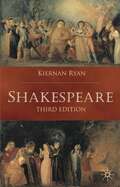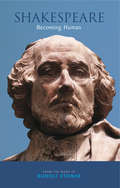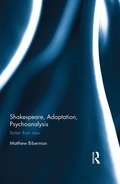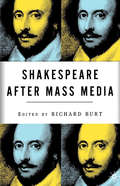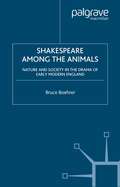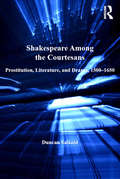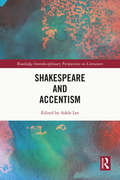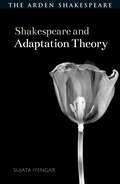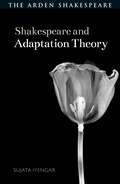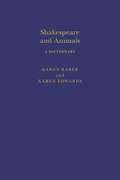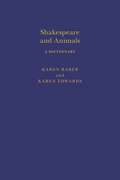- Table View
- List View
Shakespeare: Third Edition (Longman Critical Readers Ser.)
by Kiernan RyanFirst published to critical acclaim in 1989, this book is now recognised as one of the most original and influential critical studies of Shakespeare to have appeared in recent times.For this brand-new edition, Kiernan Ryan has not only revised and updated the text throughout, but he has also added a great deal of new material, expanding the book to twice the size of the first edition. The section on Shakespearean comedy now includes an essay on Shakespeare's first scintillating experiment in the genre, The Comedy of Errors, and a study of his most perplexing problem play, Measure for Measure.A provocative new last chapter, '"Dreaming on things to come": Shakespeare and the Future of Criticism', reveals how much modern criticism can learn from the appropriation of Shakespeare by Oscar Wilde, George Bernard Shaw and James Joyce.Students, teachers, and anyone with a passionate interest in what the plays have to say to us today, will find this modern classic of Shakespeare criticism indispensable.
Shakespeare: Becoming Human
by Rudolf Steiner'Like so much of Renaissance Art, Shakespeare's work bears an open secret. The esoteric spiritual content is undisguised, though it may be unexpected and not always immediately recognized. And, like all the great artistic achievements...this work remains incomplete until we recognize and respond to its open invitation that we become active participants.' - from the IntroductionThe perennial universal appeal of Shakespeare's work is well established. His core themes explore the challenges of the human condition whilst celebrating the potential of human beings to achieve and develop in earthly life. But what is it that enables Shakespeare's characters to live and breathe beyond the confines of their written roles, some 400 years after the plays were first performed? In these collected lectures, edited with an extensive introduction by Andrew Wolpert, Rudolf Steiner throws new light on the Bard's work, describing the on-going life that flows from it, and the profound spiritual origins of Shakespeare's inspirations. He shows how Shakespeare can enliven us in our longing for contemporary ideals and truths; indeed, in our goal of becoming fully human. Our engagement with the plays, not just as actors and directors, but also as students and members of an audience, can thus become a co-creative participation in the redemptive potential of Shakespeare's enduring legacy. Steiner speaks about Shakespeare in connection with the evolution of the arts of poetry and drama, and the transitions between cultural epochs. He reminds us of the sources and characteristics of classical Greek drama, recalling Aristotle's definition of drama as catharsis, and pointing to Shakespeare's connection to these cultural and historical wellsprings.
Shakespeare: A Readers' Guides To Essential Criticism (Readers' Guides to Essential Criticism)
by Nicolas TredellA stimulating and comprehensive critical survey of the responses to A Midsummer Night's Dream, as well as the key debates and developments, from the seventeenth century to the present day. Leading the reader through material chronologically, the Guide explores the main themes and interpretations and draws on a rich range of critical writings.
Shakespeare: A Readers' Guides To Essential Criticism (Readers' Guides to Essential Criticism)
by Gillian WoodsThis guide surveys the truly essential criticism of the play over the last four centuries, from 16th-century responses to the present day. Discussing key areas of debate, and a wide range of scholarship, Gillian Woods provides an invaluable introduction to the vast array of criticism surrounding one of Shakespeare's most popular plays.
Shakespeare, Adaptation, Psychoanalysis: Better than New
by Matthew BibermanIn Shakespeare, Adaptation, Psychoanalysis, Matthew Biberman analyzes early adaptations of Shakespeare’s plays in order to identify and illustrate how both social mores and basic human psychology have changed in Anglo-American culture. Biberman contests the received wisdom that Shakespeare’s characters reflect essentially timeless truths about human nature. To the contrary, he points out that Shakespeare’s characters sometimes act and think in ways that have become either stigmatized or simply outmoded. Through his study of the adaptations, Biberman pinpoints aspects of Shakespeare’s thinking about behavior and psychology that no longer ring true because circumstances have changed so dramatically between his time and the time of the adaptation. He shows how the adaptors’ changes reveal key differences between Shakespeare’s culture and the culture that then supplanted it. These changes, once grasped, reveal retroactively some of the ways in which Shakespeare’s characters do not act and think as we might expect them to act and think. Thus Biberman counters Harold Bloom’s claim that Shakespeare fundamentally invents our sense of the human; rather, he argues, our sense of the human is equally bound up in the many ways that modern culture has come to resist or outright reject the behavior we see in Shakespeare’s plays. Ultimately, our current sense of 'the human' is bound up not with the adoption of Shakespeare’s psychology, perhaps, but its adaption-or, in psychoanalytic terms, its repression and replacement.
Shakespeare, Adaptation, Psychoanalysis: Better than New
by Matthew BibermanIn Shakespeare, Adaptation, Psychoanalysis, Matthew Biberman analyzes early adaptations of Shakespeare’s plays in order to identify and illustrate how both social mores and basic human psychology have changed in Anglo-American culture. Biberman contests the received wisdom that Shakespeare’s characters reflect essentially timeless truths about human nature. To the contrary, he points out that Shakespeare’s characters sometimes act and think in ways that have become either stigmatized or simply outmoded. Through his study of the adaptations, Biberman pinpoints aspects of Shakespeare’s thinking about behavior and psychology that no longer ring true because circumstances have changed so dramatically between his time and the time of the adaptation. He shows how the adaptors’ changes reveal key differences between Shakespeare’s culture and the culture that then supplanted it. These changes, once grasped, reveal retroactively some of the ways in which Shakespeare’s characters do not act and think as we might expect them to act and think. Thus Biberman counters Harold Bloom’s claim that Shakespeare fundamentally invents our sense of the human; rather, he argues, our sense of the human is equally bound up in the many ways that modern culture has come to resist or outright reject the behavior we see in Shakespeare’s plays. Ultimately, our current sense of 'the human' is bound up not with the adoption of Shakespeare’s psychology, perhaps, but its adaption-or, in psychoanalytic terms, its repression and replacement.
Shakespeare After Mass Media
by R. BurtShakespeare in mass media - particularly film, video, and television - is arguably the hottest, fastest growing research agenda in Shakespeare studies. Shakespeare after Mass Media provides students and scholars with the most comprehensive resource available on the market for studying the pop cultural afterlife of The Bard. From marketing to electronic Shakespeare, comics to romance novels, Star Trek to Branagh, radio and popular music to Bartlett's Quotations , the volume explores the contemporary cultural significance of Shakespeare in an unprecedently broad array of mass media contexts. With theoretical sophistication and accessible writing, it will be the ideal text for courses on Shakespeare and mass media.
Shakespeare After Theory
by David Scott KastanThe most familiar assertion of Shakespeare scholarship is that he is our contemporary. Shakespeare After Theory provocatively argues that he is not, but what value he has for us must at least begin with a recognition of his distance from us.
Shakespeare After Theory
by David Scott KastanThe most familiar assertion of Shakespeare scholarship is that he is our contemporary. Shakespeare After Theory provocatively argues that he is not, but what value he has for us must at least begin with a recognition of his distance from us.
Shakespeare Among the Animals: Nature and Society in the Drama of Early Modern England (Early Modern Cultural Studies 1500–1700)
by B. BoehrerShakespeare Among the Animals examines the role of animal-metaphor in the Shakespeare stage, particularly as such metaphor serves to underwrite various forms of social difference. Working through texts such as Shakespeare's Midsummer Night's Dream , Jonson's Volpone , and Middleton's A Chaste Maid in Cheapside , different chapters of the study focus upon the allegedly natural character of femininity, masculinity, and ethnicity, while a fourth chapter considers the nature of the natural world itself as it appears on the Renaissance stage. Addressing each of these topics in turn, Shakespeare Among the Animals explores the notions of cultural order that underlie early modern conceptions of the natural world, and the ideas of nature implicit in early modern social practice.
Shakespeare Among the Courtesans: Prostitution, Literature, and Drama, 1500-1650 (Anglo-Italian Renaissance Studies)
by Duncan SalkeldCourtesans - women who achieve wealth, status, or power through sexual transgression - have played both a central and contradictory role in literature: they have been admired, celebrated, feared, and vilified. This study of the courtesan in Renaissance English drama focuses not only on the moral ambivalence of these women, but with special attention to Anglo-Italian relations, illuminates little known aspects of their lives. It traces the courtesan from a wry comedic character in the plays of Terence and Plautus to its literary exhaustion in the seventeenth-century dramatic works of Dekker, Marston, Webster, Middleton, Shirley and Brome. The author focuses especially on the presentation of the courtesan in the sixteenth century - dramas by Shakespeare, Marlowe, and Lyly view the courtesan as a symbol of social disease and decay, transforming classical conventions into English prejudices. Renaissance Anglo-Italian cultural and sexual relations are also investigated through comparisons of travel narratives, original source materials, and analysis of Aretino's representations of celebrated Italian courtesans. Amid these fascinating tales of aspiration, desire and despair lingers the intriguing question of who was the 'dark lady' of Shakespeare's sonnets.
Shakespeare Among the Courtesans: Prostitution, Literature, and Drama, 1500-1650 (Anglo-Italian Renaissance Studies)
by Duncan SalkeldCourtesans - women who achieve wealth, status, or power through sexual transgression - have played both a central and contradictory role in literature: they have been admired, celebrated, feared, and vilified. This study of the courtesan in Renaissance English drama focuses not only on the moral ambivalence of these women, but with special attention to Anglo-Italian relations, illuminates little known aspects of their lives. It traces the courtesan from a wry comedic character in the plays of Terence and Plautus to its literary exhaustion in the seventeenth-century dramatic works of Dekker, Marston, Webster, Middleton, Shirley and Brome. The author focuses especially on the presentation of the courtesan in the sixteenth century - dramas by Shakespeare, Marlowe, and Lyly view the courtesan as a symbol of social disease and decay, transforming classical conventions into English prejudices. Renaissance Anglo-Italian cultural and sexual relations are also investigated through comparisons of travel narratives, original source materials, and analysis of Aretino's representations of celebrated Italian courtesans. Amid these fascinating tales of aspiration, desire and despair lingers the intriguing question of who was the 'dark lady' of Shakespeare's sonnets.
Shakespeare and: The Merry Wives of Windsor (ISSN)
by Elizabeth SchaferSeismic shifts in the theatrical meanings of The Merry Wives of Windsor have taken place across the centuries as Shakespeare’s frequently performed play has relocated to Windsor across the world, journeying along the production/adaptation/appropriation continuum.This (eco-)performance history of Shakespeare’s The Merry Wives of Windsor not only offers the first in-depth analysis of the play in production, with a particular focus on the representation of merry women, but also utilises the comedy’s forest-aware dramaturgy to explore Mistress Page’s concept of being ‘frugal in my mirth’ in relation to sustainable theatre practices. Herne’s Oak – the fictitious tree in Windsor Forest where everyone meets in the final scene of the play – is utilised to enable a maverick but ecologically based reframing of the productions of Merry Wives analysed here.This study engages with gender, physical comedy, and cultural relocations of Windsor across the world to offer new insight into Merry Wives and its theatricality.
Shakespeare and: The Merry Wives of Windsor (ISSN)
by Elizabeth SchaferSeismic shifts in the theatrical meanings of The Merry Wives of Windsor have taken place across the centuries as Shakespeare’s frequently performed play has relocated to Windsor across the world, journeying along the production/adaptation/appropriation continuum.This (eco-)performance history of Shakespeare’s The Merry Wives of Windsor not only offers the first in-depth analysis of the play in production, with a particular focus on the representation of merry women, but also utilises the comedy’s forest-aware dramaturgy to explore Mistress Page’s concept of being ‘frugal in my mirth’ in relation to sustainable theatre practices. Herne’s Oak – the fictitious tree in Windsor Forest where everyone meets in the final scene of the play – is utilised to enable a maverick but ecologically based reframing of the productions of Merry Wives analysed here.This study engages with gender, physical comedy, and cultural relocations of Windsor across the world to offer new insight into Merry Wives and its theatricality.
Shakespeare and Accentism (Routledge Interdisciplinary Perspectives on Literature)
by Adele LeeThis collection explores the consequences of accentism—an under-researched issue that intersects with racism and classism—in the Shakespeare industry across languages and cultures, past and present. It adopts a transmedia and transhistorical approach to a subject that has been dominated by the study of "Original Pronunciation." Yet the OP project avoids linguistically "foreign" characters such as Othello because of the additional complications their "aberrant" speech poses to the reconstruction process. It also evades discussion of contemporary, global practices and, underpinning the enterprise, is the search for an aural "purity" that arguably never existed. By contrast, this collection attends to foreign speech patterns in both the early modern and post-modern periods, including Indian, East Asian, and South African, and explores how accents operate as "metasigns" reinforcing ethno-racial stereotypes and social hierarchies. It embraces new methodologies, which includes reorienting attention away from the visual and onto the aural dimensions of performance.
Shakespeare and Accentism (Routledge Interdisciplinary Perspectives on Literature)
by Adele LeeThis collection explores the consequences of accentism—an under-researched issue that intersects with racism and classism—in the Shakespeare industry across languages and cultures, past and present. It adopts a transmedia and transhistorical approach to a subject that has been dominated by the study of "Original Pronunciation." Yet the OP project avoids linguistically "foreign" characters such as Othello because of the additional complications their "aberrant" speech poses to the reconstruction process. It also evades discussion of contemporary, global practices and, underpinning the enterprise, is the search for an aural "purity" that arguably never existed. By contrast, this collection attends to foreign speech patterns in both the early modern and post-modern periods, including Indian, East Asian, and South African, and explores how accents operate as "metasigns" reinforcing ethno-racial stereotypes and social hierarchies. It embraces new methodologies, which includes reorienting attention away from the visual and onto the aural dimensions of performance.
Shakespeare and Adaptation Theory (Shakespeare and Theory)
by Sujata IyengarShakespeare and Adaptation Theory reconsiders, after 20 years of intense critical and creative activity, the theory and practice of adapting Shakespeare to different genres and media. Organized around clusters of key metaphors, the book explicates the principal theories informing the field of Shakespearean adaptation and surveys the growing field of case studies by Shakespeare scholars. Each chapter also looks anew at a specific Shakespeare play from the perspective of a prevailing set of theories and metaphors. Having identified the key critics responsible for developing these metaphors and for framing the discussion in this way, Iyengar moves on to analyze afresh the implications of these critical frames for adaptation studies as a whole and for particular Shakespeare plays. Focusing each chapter around a different play, the book contrasts comic, tragic, and tragicomic modes in Shakespeare's oeuvre and within the major genres of adaptation (e.g., film, stage-production, novel and digital media). Each chapter seasons its theoretical discussions with a lively sprinkling of allusions to Shakespeare - ranging from TikTok to tissue-boxes, from folios and fine arts to fan work. To conclude each chapter, the author provides a case-study of three or four significant and interesting adaptations from different genres or media. A glossary of terms compiled by Philip Gilreath and the author completes the book.
Shakespeare and Adaptation Theory (Shakespeare and Theory)
by Sujata IyengarShakespeare and Adaptation Theory reconsiders, after 20 years of intense critical and creative activity, the theory and practice of adapting Shakespeare to different genres and media. Organized around clusters of key metaphors, the book explicates the principal theories informing the field of Shakespearean adaptation and surveys the growing field of case studies by Shakespeare scholars. Each chapter also looks anew at a specific Shakespeare play from the perspective of a prevailing set of theories and metaphors. Having identified the key critics responsible for developing these metaphors and for framing the discussion in this way, Iyengar moves on to analyze afresh the implications of these critical frames for adaptation studies as a whole and for particular Shakespeare plays. Focusing each chapter around a different play, the book contrasts comic, tragic, and tragicomic modes in Shakespeare's oeuvre and within the major genres of adaptation (e.g., film, stage-production, novel and digital media). Each chapter seasons its theoretical discussions with a lively sprinkling of allusions to Shakespeare - ranging from TikTok to tissue-boxes, from folios and fine arts to fan work. To conclude each chapter, the author provides a case-study of three or four significant and interesting adaptations from different genres or media. A glossary of terms compiled by Philip Gilreath and the author completes the book.
Shakespeare and Animals: A Dictionary (Arden Shakespeare Dictionaries)
by Karen Raber Karen EdwardsThis encyclopaedic account of animals in Shakespeare's plays and poems, provides readers with a much-needed resource by which to navigate the recent outpouring of critical and historical work on the topic. This dictionary extends its coverage to include insects, fish and mythic creatures, as well as the places, practices and lore pertaining to all animal-oriented experiences of early modern life. It emphasizes the role of animality in defining character, and is attentive to the instabilities of the human-animal boundary as they were theatrically represented, exploited and interrogated, but it is also concerned with the material presence of animals on stage and in everyday life in Shakespeare's world. The volume is a new tool for instructors, but is also a resource for critics and scholars in the many disciplines engaged with animal studies, posthumanist theory, ecostudies and cultural studies.
Shakespeare and Animals: A Dictionary (Arden Shakespeare Dictionaries)
by Karen Raber Karen EdwardsThis encyclopaedic account of animals in Shakespeare's plays and poems, provides readers with a much-needed resource by which to navigate the recent outpouring of critical and historical work on the topic. This dictionary extends its coverage to include insects, fish and mythic creatures, as well as the places, practices and lore pertaining to all animal-oriented experiences of early modern life. It emphasizes the role of animality in defining character, and is attentive to the instabilities of the human-animal boundary as they were theatrically represented, exploited and interrogated, but it is also concerned with the material presence of animals on stage and in everyday life in Shakespeare's world. The volume is a new tool for instructors, but is also a resource for critics and scholars in the many disciplines engaged with animal studies, posthumanist theory, ecostudies and cultural studies.
Shakespeare and Appropriation: George Eliot, A. C. Swinburne, Robert Browning, And Charles Dickens (Accents on Shakespeare)
by Christy Desmet Robert SawyerThe vitality of our culture is still often measured by the status Shakespeare has within it. Contemporary readers and writers continue to exploit Shakespeare's cultural afterlife in a vivid and creative way. This fascinating collection of original essays shows how writers' efforts to imitate, contradict, compete with, and reproduce Shakespeare keep him in the cultural conversation. The essays: * analyze the methods and motives of Shakespearean appropriation * investigate theoretically the return of the repressed author in discussions of Shakespeare's cultural function * put into dialogue theoretical and literary responses to Shakespeare's cultural authority * analyze works ranging from nineteenth century to the present, and genres ranging from poetry and the novel to Disney movies.
Shakespeare and Appropriation (Accents on Shakespeare)
by Christy Desmet Robert SawyerThe vitality of our culture is still often measured by the status Shakespeare has within it. Contemporary readers and writers continue to exploit Shakespeare's cultural afterlife in a vivid and creative way. This fascinating collection of original essays shows how writers' efforts to imitate, contradict, compete with, and reproduce Shakespeare keep him in the cultural conversation. The essays: * analyze the methods and motives of Shakespearean appropriation * investigate theoretically the return of the repressed author in discussions of Shakespeare's cultural function * put into dialogue theoretical and literary responses to Shakespeare's cultural authority * analyze works ranging from nineteenth century to the present, and genres ranging from poetry and the novel to Disney movies.
Shakespeare and Asia (Routledge Studies in Shakespeare)
by Jonathan Locke HartShakespeare and Asia brings together innovative scholars from Asia or with Asian connections to explore these matters of East-West and global contexts then and now. The collection ranges from interpretations of Shakespeare’s plays and his relations with other authors like Marlowe and Dickens through Shakespeare and history and ecology to studies of film, opera or scholarship in Japan, Russia, India, Pakistan, Singapore, Taiwan and mainland China. The adaptations of Kozintsev and Kurosawa; Bollywood adaptations of Shakespeare’s plays; different Shakespearean dramas and how they are interpreted, adapted and represented for the local Pakistani audience; the Peking-opera adaptation of Hamlet ; Féng Xiǎogāng’s The Banquet as an adaptation of Hamlet; the ideology of the film, Shakespeare Wallah. Asian adaptations of Hamlet will be at the heart of this volume. Hamlet is also analyzed in light of Oedipus and the Sphinx. Shakespeare is also considered as a historicist and in terms of what influence he has on Chinese writers and historical television. Lear is Here and Cleopatra and Her Fools, two adapted Shakespearean plays on the contemporary Taiwanese stage, are also discussed. This collection also examines in Shakespeare the patriarchal prerogative and notion of violence; carnival and space in the comedies; the exotic and strange; and ecology. The book is rich, ranging and innovative and will contribute to Shakespeare studies, Shakespeare and media and film, Shakespeare and Asia and global Shakespeare.
Shakespeare and Asia (Routledge Studies in Shakespeare)
by Jonathan Locke HartShakespeare and Asia brings together innovative scholars from Asia or with Asian connections to explore these matters of East-West and global contexts then and now. The collection ranges from interpretations of Shakespeare’s plays and his relations with other authors like Marlowe and Dickens through Shakespeare and history and ecology to studies of film, opera or scholarship in Japan, Russia, India, Pakistan, Singapore, Taiwan and mainland China. The adaptations of Kozintsev and Kurosawa; Bollywood adaptations of Shakespeare’s plays; different Shakespearean dramas and how they are interpreted, adapted and represented for the local Pakistani audience; the Peking-opera adaptation of Hamlet ; Féng Xiǎogāng’s The Banquet as an adaptation of Hamlet; the ideology of the film, Shakespeare Wallah. Asian adaptations of Hamlet will be at the heart of this volume. Hamlet is also analyzed in light of Oedipus and the Sphinx. Shakespeare is also considered as a historicist and in terms of what influence he has on Chinese writers and historical television. Lear is Here and Cleopatra and Her Fools, two adapted Shakespearean plays on the contemporary Taiwanese stage, are also discussed. This collection also examines in Shakespeare the patriarchal prerogative and notion of violence; carnival and space in the comedies; the exotic and strange; and ecology. The book is rich, ranging and innovative and will contribute to Shakespeare studies, Shakespeare and media and film, Shakespeare and Asia and global Shakespeare.
Shakespeare and Audience in Practice (Shakespeare in Practice)
by Stephen PurcellWhat do audiences do as they watch a Shakespearean play? What makes them respond in the ways that they do? This book examines a wide range of theatrical productions to explore the practice of being a modern Shakespearean audience. It surveys some of the most influential ideas about spectatorship in contemporary performance studies, and analyses the strategies employed both in the texts themselves and by modern theatre practitioners to position audiences in particular ways.
